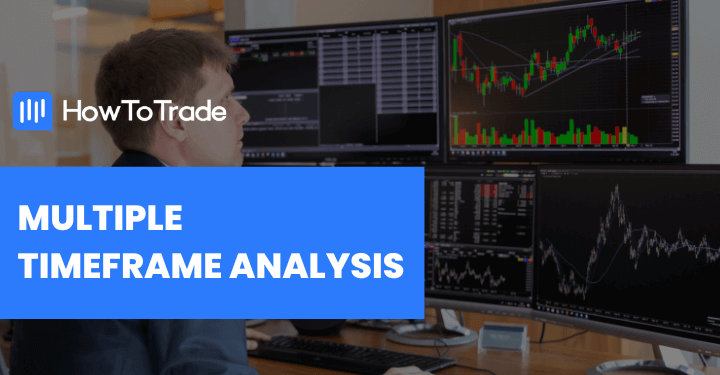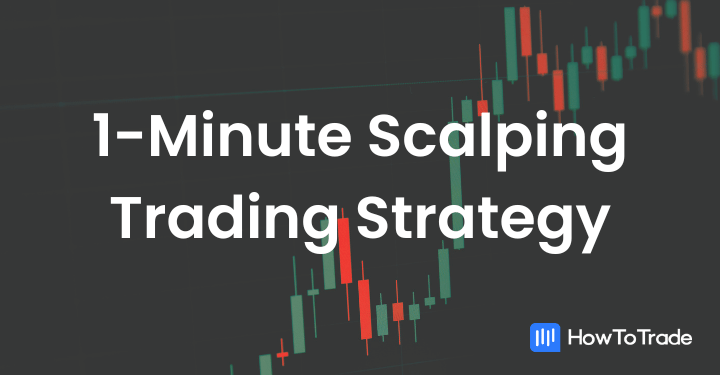
- The 1-Minute Scalping Strategy aims for quick, small profits by exploiting rapid price movements within a one-minute time frame.
- Essential indicators for this strategy include the Exponential Moving Average (EMA) for trend direction, the Stochastic Oscillator for overbought or oversold conditions, and the Relative Strength Index (RSI) to assess price movement speed and changes.
- It is best suited for traders comfortable with high-stress, high-risk environments and requires a disciplined, well-informed approach, making it less ideal for beginners or those used to longer-term trading.
At some point, every trader understands that the market is fractal. That is, price action on higher timeframes is similar to the ones in the lower timeframes. So, this gives rise to scalping strategies. The lowest timeframe that is available is the 1-minute timeframe, which is often used by many traders to capture some quick profits.
In this article, we will tear apart what scalping entails, how to trade the 1-minute scalping strategy to make quick profits and lots more. So, before we dive into the details, here’s a sneak peek into what you’ll learn on this page:
- The rules and setup of the 1-minute trading strategy
- Reasons to use the 1-minute timeframe in scalping
- Best indicators to combine with the 1-minute price chart
- How to trade using the 1-minute scalping strategy
 Table of Contents
Table of Contents
What is the 1-Minute Scalping Strategy?
As the name suggests, the 1-Minute Scalping Strategy is a specialized trading approach focused on the 1-minute time frame, aiming to make quick, small profits by capitalizing on rapid price movements within this short window.
Generally, as a trading strategy, scalping has its challenges and risks. It requires intense focus and discipline, as the strategy involves entering and exiting positions quickly. A successful scalper can make multiple trades in a day to achieve a predetermined profit target. Quite often, they make hundreds of trades in a single day. This can be mentally taxing and demands a trader to stay calm under pressure. Additionally, the strategy can lead to higher trading costs due to the frequent number of trades made, and market noise can significantly impact profitability.
Since scalpers typically look for extremely minor price movements, they analyze the markets on short timeframes. The lowest timeframe known in trading is the 1 minute, in which opinions vary regarding its efficiency. Some might say it’s not a long timeframe enough to rely on it, while others argue it is certainly possible to use it to make quick profits. Regardless, the idea of 1-minute scalping is to find specific chart patterns and other trading signals to capture those extremely short-term price movements.
Is the 1 Minute Time Frame Good for Scalping?
The 1-minute time frame is suitable for scalping, but it’s essential to understand its nature and requirements for successful implementation. Scalping on this time frame is a short-term, fast-paced trading style focusing on small price movements. Traders who excel in this method are typically adept at making quick decisions and can handle the high-stress environment it creates.
One of the key advantages of the 1-minute scalping strategy is the potential for quick profits due to the many trades that can be made in a day. This high-frequency trading environment offers continuous opportunities for traders who are comfortable with rapid decision-making and can efficiently analyze price movements on short timeframes.
Given these aspects, the 1-minute scalping strategy is best suited for traders who can dedicate the time and focus required for this demanding trading style. It’s recommended that traders also understand the principles of day trading or swing trading before moving on to scalping. This approach ensures a better understanding of the market and helps develop the necessary skills to manage the rapid decision-making process inherent in 1-minute scalping. Additionally, many scalpers use sophisticated tools such as level 2 market data and VPS services to increase their chances of success.
Take note that the 1-minute scalping strategy is particularly effective in high-volume markets, such as the forex market. It is almost impossible to utilize this strategy in markets with low liquidity. In forex trading, the market conditions are different since there’s always liquidity, especially when trading major currency pairs. As such, scale forex traders often apply this forex scalping strategy on a currency pair with high trading volume. Also, since the trading costs of forex scalping strategies are quite high, it is crucial to choose a forex scalping broker that provides convenient trading conditions and low trading costs for this type of trading.
Best Indicators for the 1-Minute Scalping Strategy
When it comes to 1-minute scalping strategies, several key indicators are crucial for making informed and quick trading decisions. These momentum technical indicators are tailored to capture the rapid price movements characteristic of this short timeframe, aiming to secure small, consistent profits. Let’s delve into the most effective indicators for the 1-minute scalping strategy:
1. Simple Moving Average (SMA) and Exponential Moving Average (EMA):
These are fundamental indicators for trend identification in scalping. The SMA calculates the average price over a specific period, assigning equal weight to all prices. In contrast, Exponential Moving Averages give more weight to recent prices, making them more responsive to new market information. A common approach combines the 50-day EMA and the 100-day EMA to discern trend directions. Another popular technique includes the 8, 13, and 21 EMA strategy.
2. Stochastic Oscillator
This momentum indicator is crucial for identifying overbought or oversold conditions in the market. It operates within a range of 0 to 100, with readings above 80 indicating overbought conditions and readings below 20 suggesting oversold conditions. This tool is beneficial for predicting potential price reversals in a 1-minute timeframe.
3. Relative Strength Index (RSI)
The RSI is a popular momentum indicator used to measure the speed and change of price movements. It helps traders to identify the market’s momentum and capitalize on small price shifts within the 1-minute timeframe. It’s integral to the scalping strategy, providing insights into potential upcoming movements.
4. Bollinger Bands
These assess market volatility and identify overbought or oversold conditions. In a 1-minute scalping strategy, traders often look for price breaches of the Bollinger Bands as potential entry points, depending on whether the market is in an uptrend or downtrend.
5. MACD (Moving Average Convergence Divergence)
This indicator is useful for revealing changes in the strength, direction, momentum, and duration of a trend in a stock’s price. It’s calculated by subtracting the 26-day EMA from the 12-day EMA, with the 9-day EMA serving as the signal line to highlight buy and sell signals.
Each of these indicators plays a specific role in informing trading decisions, and their effectiveness depends on the ability to interpret them correctly in the context of market conditions. For more information, we suggest you visit our comprehensive guide about the best scalping indicators to use in trading.
How to Trade the 1-Minute Scalping Strategy?
Now that we have knocked the basics out of the way, let’s see how to trade the 1 Minute Scalping Strategy using two trading techniques – the Triple EMAs Strategy and the 1-Minute EMA and Stochastic Strategy.
The 1-Minute Triple EMAs ScalpingStrategy
With this strategy, traders combine three different EMAs – the 50, 100, and 150 EMA.
So, before we dive into how to Use the strategy, we have to set the following indicators on our TradingView chart:
- 50 EMA – Blue
- 100 EMA – Yellow
- 150 EMA – Red
The 50 EMA shows us the shorter-term trend and sentiment, while the 100 and 150 EMA shows us the longer-term trend; combining these three allows us only to enter a trade when the trend is in our favor. Remember, the trend is your friend.
Here’s what your chart should look like after installing the indicators:
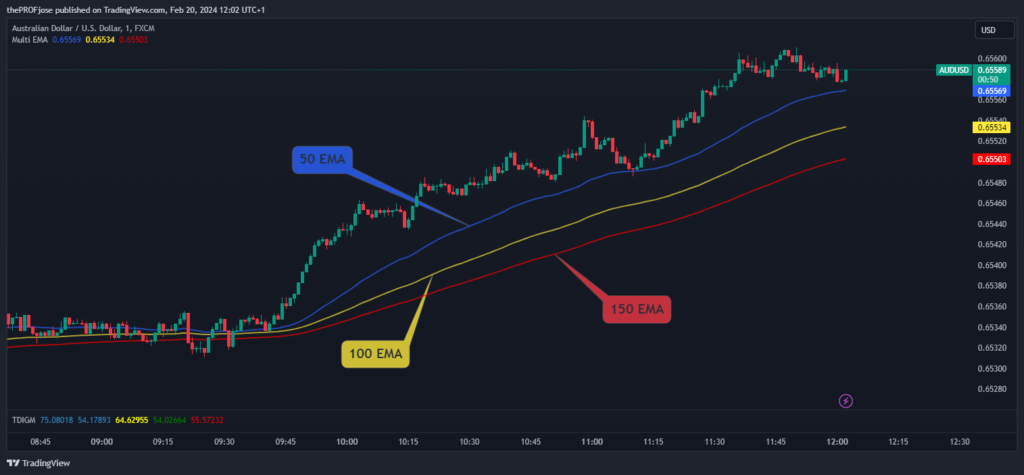
Trading Rules
The trading rules for this strategy are quite simple – you are looking for a crossover of the price action below or above the EMA lines. At first, you need to identify the trend. To do this, we must pay attention to the following:
- For an uptrend, the price must be clearly above the 50, 100, and 150 EMA.
- For a downtrend, the price must be clearly below the 50, 100, and 150 EMA.
- The three EMA must be spread widely apart, having a slope of 30° and above for an uptrend or – 30° and below for a downtrend.
Here’s an example of a market in a downtrend:
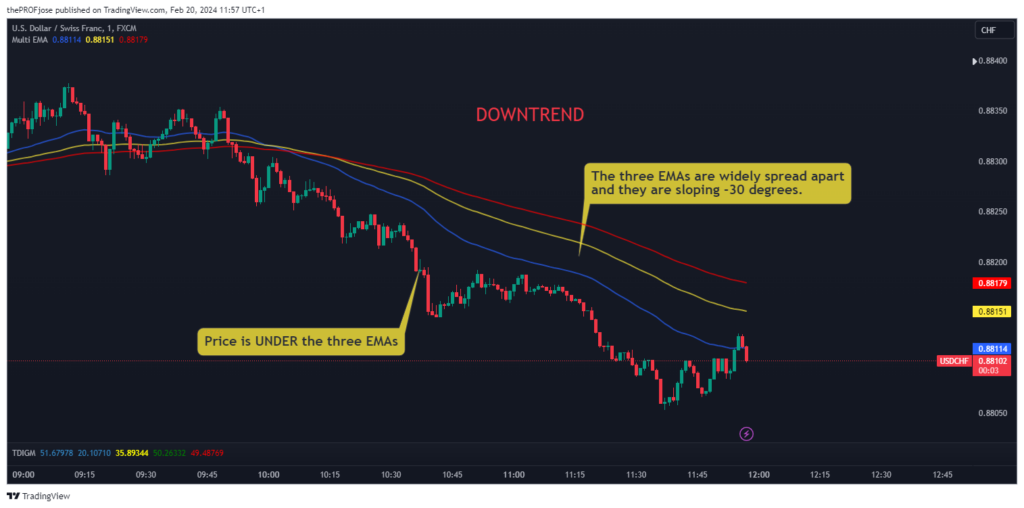
As you can see, traders can primarily use the EMA lines to identify the trend. However, they can also use the crossover to enter and exit trades.
Entry and Exit Rules
Figuring out the trend is the most important step in using this strategy. Once we’ve done that, we can look for our trading entry. For the sake of this example, we will use a downtrend as an illustration.
Here’s how to determine an entry:
Whenever the price retraces/pulls back to either the 50 or the 100 EMA and then rebounds to continue the trend, we place a SELL order immediately after the first candle closes before the 50 EMA. Here’s how it looks on the chart:
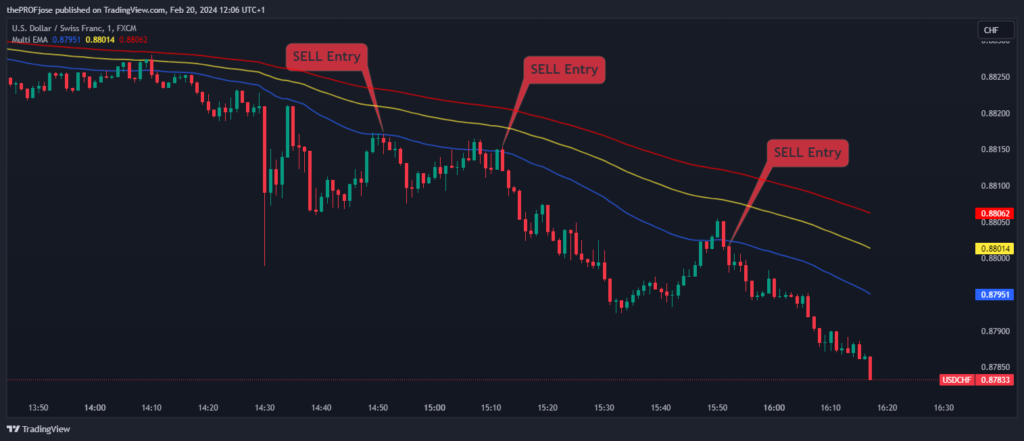
There are many ways to manage your trade, but the simplest and most effective method is setting a fixed target profit at a 1.5 risk-reward ratio.
So, how do you place your stop loss? Here’s how: place the stop loss above the swing high (in a downtrend) or below the swing low (in an uptrend). Here’s an example:
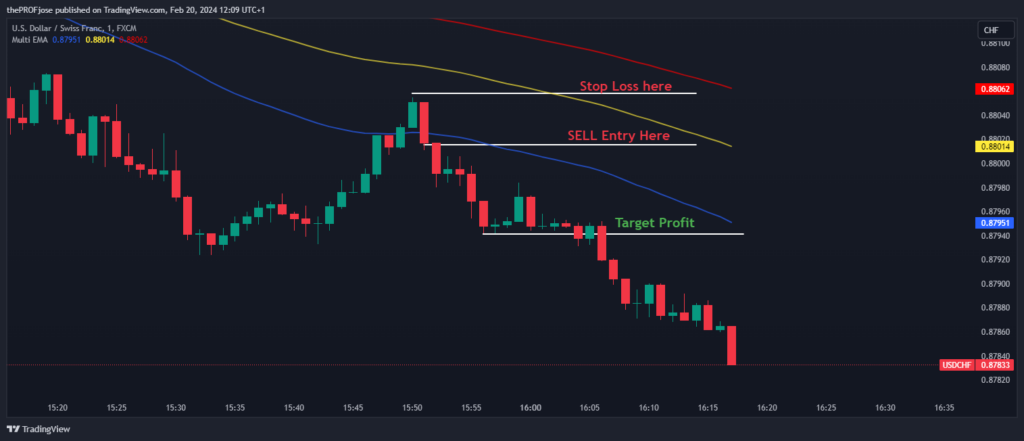
Alternatively, if you have more time to monitor price action, you can also trail your stop loss as the price continues moving in your direction. This way, you can ride the trend for long.
1-Minute EMA and Stochastic Oscillator Scalping Strategy
We all know that long trends don’t happen daily, but this shouldn’t stop you from trading as a scalper. Many traders favor a sideways market condition so they can utilize the range trading strategy. In this market mode, you can jump in and out of many trades in a single day without attempting to ride a long trend, and this second 1-minute scalping strategy teaches you just how to do that.
So, here is a list of indicators to add to our trading chart to make this work:
- 50 and 200 EMA
- Stochastic Oscillator (Default settings)
If you install them correctly, your chart should look something like this:

Trading Rules
Now to the meat and potatoes of the strategy: the entry rules. For the sake of this illustration, we will use a BUY scenario. However, you can take a sell trade using a similar approach.
Here are the things you want to see before you open a buy trade:
- Price is above the 50 and 200 EMA
- Enter a buy trade immediately when the Stochastic Oscillator crosses above the 20 levels.
Here’s how it looks on the chart:
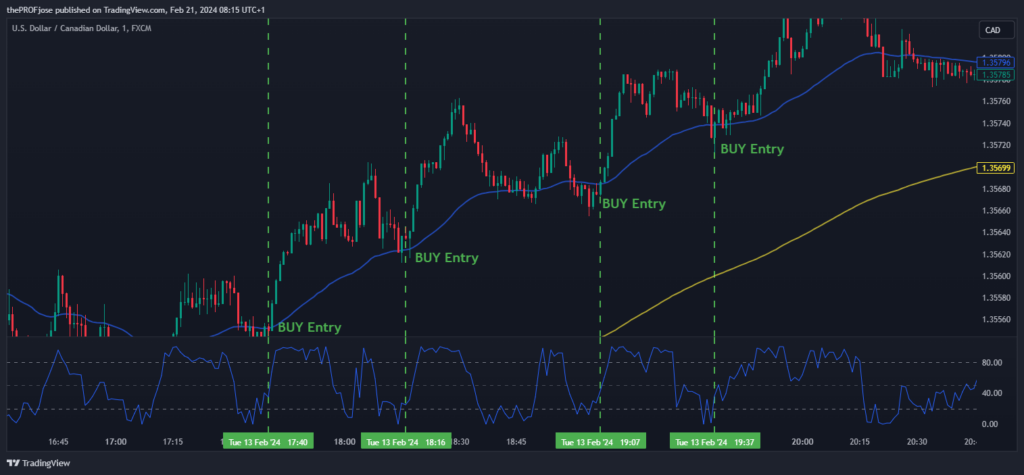
From the above chart, you can see that we have a lot of entry opportunities within a short period. So, you want to get in and out of your trades quickly.
Risk Management
Scalping can quickly go wrong if you don’t have solid risk management rules. One of the most important things is to set rules that guide where you place your stop loss and target profit orders. There are many ways you can go about this; however, one common way is to do the following:
- Set the stop loss around 1 or 2 Pips below the closest swing low in a buy trade. For a sell trade, place it above the closest swing high.
- Setting your target profit can be done in two ways: either set a static target point, say 1.5 risk-reward ratio, or you manually close the trade when the Stochastic Oscillator hits overbought (in a BUY trade) or oversold (in a SELL trade) levels.
The Free 1-Minute Scalping Trading Strategy PDF
If you need something to easily carry around and refer to when it comes to the 1 minute scalping trading strategy, this PDF is for you:
The Free 1-Minute Scalping Trading Strategy PDF
Is the 1-Minute Scalping Trading Strategy Profitable?
The 1-minute scalping strategy can certainly be profitable, but it’s crucial to understand its nuances and the level of commitment it requires. For instance, the profitability of this strategy hinges on disciplined execution and a solid grasp of technical indicators. Even more important, the success of the 1-minute scalping strategy heavily relies on a trader’s instincts and the skill to identify extremely short price movements.
As such, 1-minute scalping is only suitable for some traders. It’s best suited for those who can make rapid decisions, handle stress effectively, and have a keen eye for short-term market movements. Beginners or those accustomed to longer-term trading styles might find it challenging to trade in the 1-minute timeframe.
But you must try it first to know if this is the right strategy for you. If you know yourself well enough and you feel more comfortable in a fast-paced environment, then you should definitely try it out. Remember that the 1-minute scalping strategy enables you to be neutral about the market and to be out of a position most of the time. Therefore, many feel much more comfortable using this trading style.
Yet, the strategy is not without challenges. It requires managing a large number of trades within a day, as scalpers aim to accumulate many small profits. This high-frequency trading leads to higher trading costs compared to longer-term trading strategies and the risk of quick, small losses accumulating rapidly. Market noise and volatility can also significantly impact trade outcomes.
So, overall, while 1-minute scalping can be a profitable trading strategy, it demands a specific trader personality, intense focus, and a disciplined approach to risk management. If it suits you, go for it.
Risk Disclosure: The information provided in this article is not intended to give financial advice, recommend investments, guarantee profits, or shield you from losses. Our content is only for informational purposes and to help you understand the risks and complexity of these markets by providing objective analysis. Before trading, carefully consider your experience, financial goals, and risk tolerance. Trading involves significant potential for financial loss and isn't suitable for everyone.




